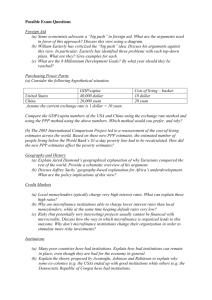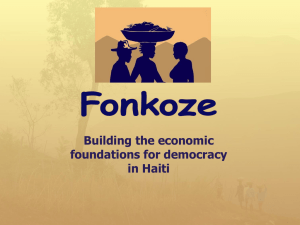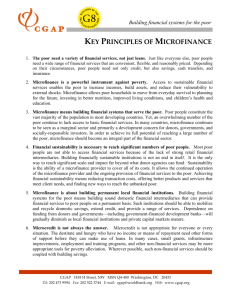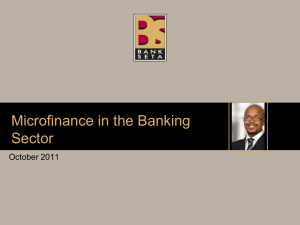PRINCIPLES OF SUSTAINABLE MICROFINANCE
advertisement
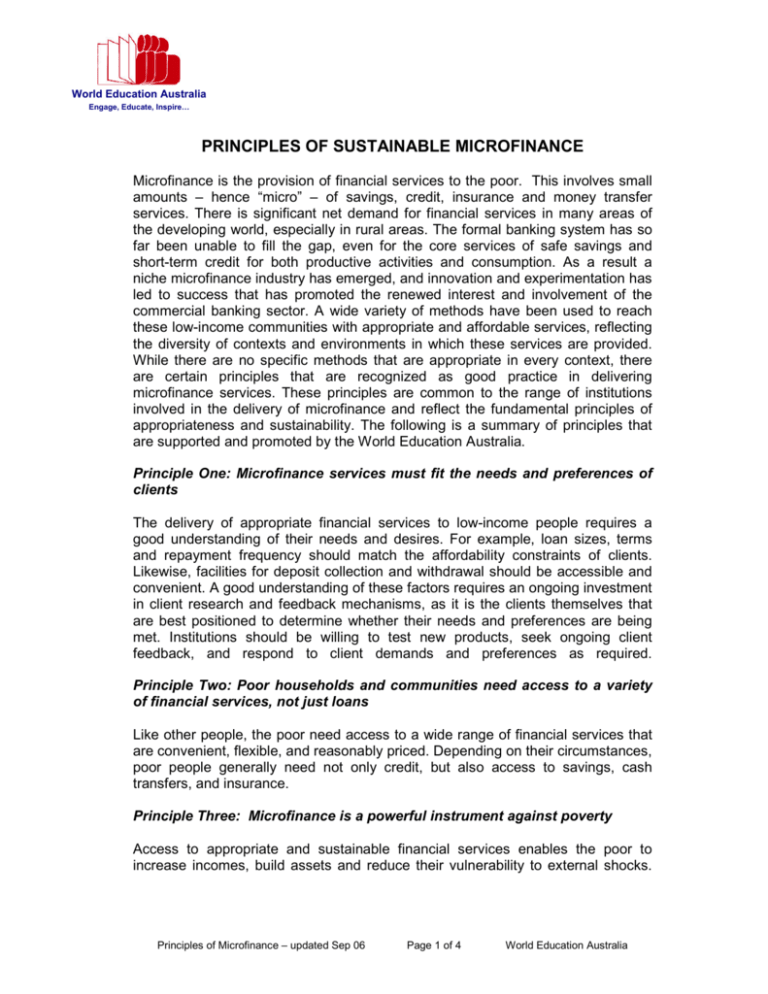
World Education Australia Engage, Educate, Inspire… PRINCIPLES OF SUSTAINABLE MICROFINANCE Microfinance is the provision of financial services to the poor. This involves small amounts – hence “micro” – of savings, credit, insurance and money transfer services. There is significant net demand for financial services in many areas of the developing world, especially in rural areas. The formal banking system has so far been unable to fill the gap, even for the core services of safe savings and short-term credit for both productive activities and consumption. As a result a niche microfinance industry has emerged, and innovation and experimentation has led to success that has promoted the renewed interest and involvement of the commercial banking sector. A wide variety of methods have been used to reach these low-income communities with appropriate and affordable services, reflecting the diversity of contexts and environments in which these services are provided. While there are no specific methods that are appropriate in every context, there are certain principles that are recognized as good practice in delivering microfinance services. These principles are common to the range of institutions involved in the delivery of microfinance and reflect the fundamental principles of appropriateness and sustainability. The following is a summary of principles that are supported and promoted by the World Education Australia. Principle One: Microfinance services must fit the needs and preferences of clients The delivery of appropriate financial services to low-income people requires a good understanding of their needs and desires. For example, loan sizes, terms and repayment frequency should match the affordability constraints of clients. Likewise, facilities for deposit collection and withdrawal should be accessible and convenient. A good understanding of these factors requires an ongoing investment in client research and feedback mechanisms, as it is the clients themselves that are best positioned to determine whether their needs and preferences are being met. Institutions should be willing to test new products, seek ongoing client feedback, and respond to client demands and preferences as required. Principle Two: Poor households and communities need access to a variety of financial services, not just loans Like other people, the poor need access to a wide range of financial services that are convenient, flexible, and reasonably priced. Depending on their circumstances, poor people generally need not only credit, but also access to savings, cash transfers, and insurance. Principle Three: Microfinance is a powerful instrument against poverty Access to appropriate and sustainable financial services enables the poor to increase incomes, build assets and reduce their vulnerability to external shocks. Principles of Microfinance – updated Sep 06 Page 1 of 4 World Education Australia Microfinance allows poor households to move from everyday survival to planning for the future, investing in better nutrition, improved living conditions, and children’s health and education. Microfinance products and services should be designed with clients’ vulnerability and poverty context in mind, and those initiatives that have a poverty reduction agenda should measure and assess their performance in terms of poverty reduction. Principle Four: Microfinance means building financial systems that serve the poor In many countries, microfinance continues to be seen as a marginal sector and primarily a development concern for donors, governments, and sociallyresponsible investors. In order to achieve its full potential of reaching a large number of poor people, microfinance needs to become an integral part of the financial sector. This requires the involvement of conventional financial service providers, regulators and related industry bodies. Principle Five: Financial sustainability is necessary to reach significant numbers of poor people Most poor people are not able to access financial services because of the lack of strong retail financial intermediaries. Building financially sustainable institutions is not an end in itself - it is necessary in order to reach significant scale and impact, far beyond what government or other donors can fund. Financial sustainability is the ability of a microfinance provider to cover all of its costs. It allows the continued operation of the microfinance provider and the ongoing provision and expansion of financial services to the poor. Achieving financial sustainability requires minimising costs, offering products and services that meet client needs, finding innovative ways to reach the un-banked poor, and charging interest rates and fees that cover costs. Microfinance providers should always strive to achieve maximum efficiency in their operations so that they can provide their services at the lowest possible cost to clients. Principle Six: Interest rate ceilings can damage poor people’s access to financial services The per unit costs involved in making many small loans are significantly higher than those associated with fewer, larger loans. Likewise, operating in high inflationary environments with weak financial markets, and engaging in uncollateralized lending to people living in remote areas, is considerably more expensive than collateralized lending to urban residents in a developed and stable economy. It is therefore not appropriate to compare interest rates and fees across countries, geographical locations, and clients. Unless microfinance providers can charge interest rates that are above average bank loan rates, they invariably cannot cover their costs, and their growth and sustainability will be limited by the scarce and uncertain supply of subsidized funding. When governments regulate interest rates, they usually set them at levels too low to permit sustainable microfinance. Principles of Microfinance – updated Sep 06 Page 2 of 4 World Education Australia At the same time, microfinance providers must avoid setting a sustainable interest rate based on an inefficient operation as this results in operational inefficiencies and related costs being passed on to poor clients and may reduce the pressure on the provider to improve its performance. In order to avoid this situation, clear pricing policies and mechanisms should be in place and shared with stakeholders and funders to ensure that all parties can together monitor interest rates to ensure their appropriateness. Principle Seven: Credit is not always appropriate Credit is not appropriate for everyone or every situation. The destitute and hungry who have no income or means of repayment typically need other forms of support before they can make effective use of loans. In many cases, small grants, community infrastructure improvements, health and education services, employment and training programs and other non-financial services may be more appropriate tools for poverty alleviation. Wherever possible, poor clients should be encouraged and supported to build a small savings base and develop basic money management skills prior to taking on the risks associated with credit. Principle Eight: The role of governments is as an enabler, not as a direct provider of financial services Governments play an important role in setting a supportive policy environment that stimulates the development of financial services while protecting poor people’s savings. Governments can best support microfinance by promoting macroeconomic stability, avoiding interest-rate caps and refraining from distorting the market with unsustainable, subsidized loan programs. Governments can also support financial services for the poor by improving the business environment for micro-entrepreneurs, clamping down on corruption, and improving access to markets and infrastructure. Government’s are not well placed to provide financial services directly to clients, and tend to distort the market and reduce the quality and level of service provision when they do so. In certain situations, government funding for sound, independent microfinance institutions may be warranted when other funding sources are not available. Principle Nine: Donor subsidies should complement, not compete with private sector capital Donors should use appropriate grant, loan, and equity instruments on a temporary basis to build the institutional capacity of financial providers, develop supporting infrastructure (like rating agencies, credit bureaus, audit capacity, etc.), and support experimental services and products. In some cases, longer-term donor subsidies may be required to reach sparsely populated and otherwise difficult-toreach populations. To be effective, donor funding must seek to integrate financial services for the poor into local financial markets; apply specialist expertise to the design and implementation of projects; require that financial institutions and other Principles of Microfinance – updated Sep 06 Page 3 of 4 World Education Australia partners meet minimum performance standards as a condition for continued support; and plan for exit from the outset. Principle Ten: The lack of institutional and human capacity is the key constraint to the expansion of microfinance Microfinance is a specialized field that combines banking with a social agenda. The technology and finance required to extend these services to the poor already exists, what is lacking in most cases is the institutional and human capacity required to link financial markets with poor clients. To address this constraint, capacity needs to be built at all levels, from financial institutions through the regulatory and supervisory bodies and information systems, to government entities and donor agencies. Investments in the sector, both public and private, should focus on building the human and institutional capacity to release the full potential of microfinance. Principle Eleven: The importance of financial and outreach transparency Because microfinance has a social agenda and involves a wide range of stakeholders, it is important that accurate and comparable information be available to monitor and assess the social and financial performance of programs. This information is required by bank supervisors, regulators, donors, investors and clients so that they can adequately assess the risks and returns associated with various providers and services. The microfinance industry is vulnerable to political interference because of its need to charge higher than usual levels of interest to poor clients. Transparent financial and outreach reporting can help to mitigate concerns related to unfair pricing of products and thereby promote the sustainability of the microfinance industry as a whole. Principles of Microfinance – updated Sep 06 Page 4 of 4 World Education Australia

